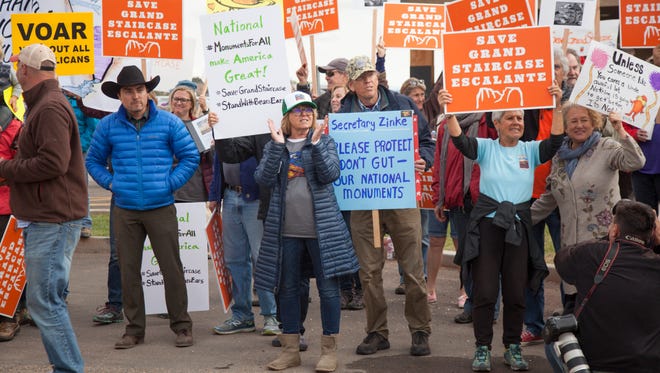‘Culture war’ plays out at Grand Staircase monument

KANAB, Utah — A clear clash of cultures was at play Wednesday as the two sides of a 20-year-old debate over the Grand Staircase-Escalante National Monument tried to make their case to visiting Interior Secretary Ryan Zinke.
Zinke, tasked by an executive order from President Trump to review two decades worth of monuments, started this week by visiting two of Utah’s: the Bears Ears National Monument, designated late last year by President Obama in the waning days of his administration, and the Grand Staircase-Escalante National Monument, where state and local leadership had their hearts hardened about monuments and a president’s ability to create them when Bill Clinton didn’t alert state leadership until the eve of his signing the designation in 1996.
Seeing the Grand Staircase provided some perspective, Zinke said, arguing the tour armed him with some perspective as he continues the review process and gave him a up-close view behind some of the emotions of the issue.
“These two are the most controversial,” Zinke said, speaking over the chanting of nearby demonstrators calling “Save our monument.”
27 national monuments under Interior Dept. review
Bears Ears monument gets visit from Interior secretary
Trump ordered the review last month, responding to complaints from Utah’s congressional leaders, fronted by Republican Sen. Orrin Hatch, who argued the monument was declared in spite of widespread local opposition, a repeat of the perception that the federal government had steamrolled local voices in 1996.
When momentum behind a monument at Bears Ears picked up steam in recent years, it rekindled some of those old grudges, and Utah’s elected officials raged against the prospects of a designation that would bend large swaths of southern Utah toward preservation instead of development.
After Clinton’s designation, officials in the nearby town of Kanab ordered flags flown at half staff, wore black, and launched black balloons in protest. Local officials have argued ever since that the monument has handcuffed economic development.
Garfield County even declared an economic emergency in 2015, citing an exodus of residents who had left looking for better jobs elsewhere.

But some locals, several hundred of whom gathered Wednesday in Kanab to protest any proposal to rescind or shrink the monument, argue the monument has been a boon, attracting tourists and new move-ins from all over the world.
“They're not coming here to see coal mines. They're coming to see national parks and monuments,” said Victor Cooper, who has owned the Rocking V Cafe in Kanab since 2000.
The problem isn’t the monument, Cooper argued, but a lack of willingness on the part of the area’s elected leadership to accept changing times.
Clinton’s designation came just in time to stop a proposed coal mine that had promised several hundred jobs in the area and millions in new revenues via royalty payments. Ever since local leaders have decried the monument as an obstacle to mining, grazing, motorized recreation and other uses.
The lack of economic diversity makes it impossible for young families to stay because they can’t find work that pays enough, said Dirk Clayson, a Kane County commissioner, arguing that the monument status doesn’t even promote much tourism.
“These people who say we have all of this tourism because of the monument are just wrong,” Clayson said, crediting the influx of visitors to a statewide effort to promote tourism and local branding efforts. He said surveys show that most visitors to the Kanab area associate it with the Grand Canyon or other surrounding high-profile attractions.

At 1.7 million acres, it is the largest monument ever declared under the 1906 Antiquities Act.
But monument supporters say they see little evidence the monument has held the area down.
A study out of Utah State University found the declaration had little or no effect on the economies of local counties, and a study by Headwaters Economics suggested monuments like Grand Staircase-Escalante attract more modern, faster-growing economic sectors.
In Escalante, which borders the monument to the north, business owners say they’ve flourished thanks to the monument.
Three new lodging facilities recently opened, and two others are under construction. New home construction is at an all-time high and business growth is steady, said Mark Austin, a building contractor and member of the Escalante-Boulder Chamber of Commerce.
“This is a culture war,” he said. “Our (elected leaders) have this idea that there’s one kind of lifestyle. They were so isolated for so long they felt like, this is all ours, and now that all these people are coming and they’re looking around feeling like they’re losing it.”
Follow David DeMille on Twitter: @SpectrumDeMille
